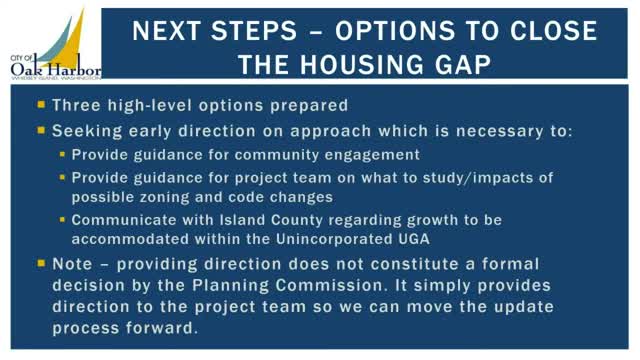City explores bold zoning changes to tackle housing crisis
August 28, 2024 | Oak Harbor, Island County, Washington
This article was created by AI summarizing key points discussed. AI makes mistakes, so for full details and context, please refer to the video of the full meeting. Please report any errors so we can fix them. Report an error »

In a recent government meeting, officials discussed critical strategies to address a significant housing shortfall in the city, revealing a need for 3,000 additional dwelling units. The meeting highlighted three potential options to tackle this issue, emphasizing the importance of adapting development regulations and zoning laws.
The first option involves conducting a land capacity analysis, which has already indicated a shortfall of 3,000 units. Officials acknowledged that simply stating the city cannot accommodate this demand is not a viable solution. They stressed the necessity of exploring further options to meet housing targets mandated by state requirements.
The second option proposes changes to development regulations, particularly increasing density limits from 22 to 38 units per acre in high-density districts. This adjustment could reduce the shortfall to 2,400 units, allowing for more efficient use of available land. Additionally, officials noted that height regulation changes may be necessary to support this increased density.
The third option combines the proposed development regulation changes with targeted rezoning of specific properties. This approach aims to further enhance housing capacity, although it would still fall short of fully addressing the 5,000-unit target identified by consultants.
Officials emphasized the evolving nature of housing planning, noting that the criteria for accommodating growth have become more stringent. The city is now required to plan not just for population growth but specifically for housing needs, which complicates the development process.
As discussions continue, city officials are committed to exploring all avenues to meet housing demands while balancing regulatory requirements and community needs. The outcome of these deliberations will play a crucial role in shaping the city's housing landscape in the coming years.
The first option involves conducting a land capacity analysis, which has already indicated a shortfall of 3,000 units. Officials acknowledged that simply stating the city cannot accommodate this demand is not a viable solution. They stressed the necessity of exploring further options to meet housing targets mandated by state requirements.
The second option proposes changes to development regulations, particularly increasing density limits from 22 to 38 units per acre in high-density districts. This adjustment could reduce the shortfall to 2,400 units, allowing for more efficient use of available land. Additionally, officials noted that height regulation changes may be necessary to support this increased density.
The third option combines the proposed development regulation changes with targeted rezoning of specific properties. This approach aims to further enhance housing capacity, although it would still fall short of fully addressing the 5,000-unit target identified by consultants.
Officials emphasized the evolving nature of housing planning, noting that the criteria for accommodating growth have become more stringent. The city is now required to plan not just for population growth but specifically for housing needs, which complicates the development process.
As discussions continue, city officials are committed to exploring all avenues to meet housing demands while balancing regulatory requirements and community needs. The outcome of these deliberations will play a crucial role in shaping the city's housing landscape in the coming years.
View full meeting
This article is based on a recent meeting—watch the full video and explore the complete transcript for deeper insights into the discussion.
View full meeting
